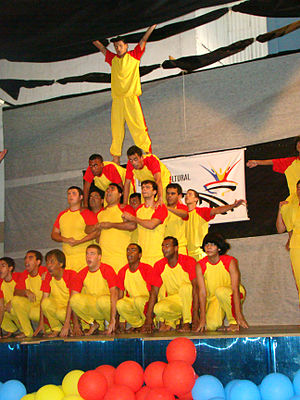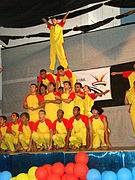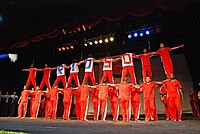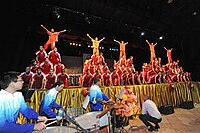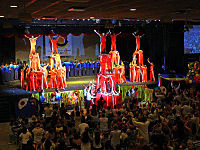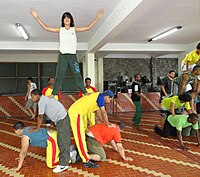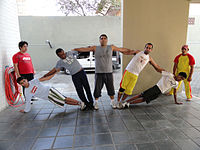Gymnastic formation has general objective of demonstration of force, passion, and union of the participants and not a modality to dispute championship. General flow is from small-light mounting to large-heavy mounting. The performance of the NGOs is widely variable, such as, bi-dimensional wave, sky rocket, windmill, walking wall, walking pyramid, catapult, instantaneous stand-up pyramid, instantaneous stand-up tower, three-layers' plane tower, four-layers' tower, and rarely five-layers' tower. The six-layers' tower that stood up in Osaka, Japan, in 1982 was indexed on the Guinness Book.

Gymnastics is a type of sport that includes physical exercises requiring balance, strength, flexibility, agility, coordination, artistry and endurance. The movements involved in gymnastics contribute to the development of the arms, legs, shoulders, back, chest, and abdominal muscle groups. Gymnastics evolved from exercises used by the ancient Greeks that included skills for mounting and dismounting a horse, and from circus performance skills.

Samba is a name or prefix used for several rhythmic variants, such as samba urbano carioca, samba de roda, recognized as part of the Intangible Cultural Heritage of Humanity by UNESCO, amongst many other forms of samba, mostly originated in the Rio de Janeiro and Bahia states.

Rhythmic gymnastics is a sport in which gymnasts perform on a floor with an apparatus: hoop, ball, clubs, ribbon and rope. The sport combines elements of gymnastics, dance and calisthenics; gymnasts must be strong, flexible, agile, dexterous and coordinated. Rhythmic gymnastics is governed by the International Gymnastics Federation (FiG), which first recognized it as a sport in 1963. It became an Olympic sport in 1984, with an individual all-around event. The group all-around competition was added to the Olympics in 1996. At the international level, rhythmic gymnastics is a women-only sport. The most prestigious competitions, besides the Olympic Games, are the World Championships, World Games, European Championships, European Games, the World Cup Series and the Grand Prix Series. Gymnasts are judged on their artistry, execution of skills, and difficulty of skills, for which they gain points. They perform leaps, balances, and rotations along with handling the apparatus.

Niterói is a municipality in the state of Rio de Janeiro, in the southeast region of Brazil. It lies across Guanabara Bay, facing the city of Rio de Janeiro and forming part of the Rio de Janeiro Metropolitan Area. It was the capital of Rio de Janeiro, as marked by its golden mural crown, from 1834 to 1894 and again from 1903 to 1975. It has an estimated population of 515,317 inhabitants (2020) and an area of 129.375 km2 (49.952 sq mi), making it the fifth most populous city in the state. It has the highest Human Development Index in the state and the seventh highest among Brazil's municipalities in 2010. Individually, it is the second municipality with the highest average monthly household income per capita in Brazil and appears in 13th place among the municipalities of the country according to social indicators related to education. The city has the nicknames of Cidade Sorriso.
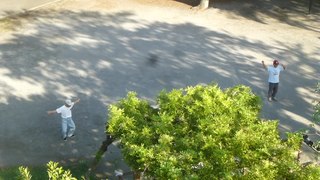
Radio calisthenics are warm-up calisthenics performed to music and guidance from radio broadcasts. Originating from the United States, they are popular in Japan and parts of China, North Korea and Taiwan.

A human pyramid is an acrobatic formation of three or more people in which two or more people support a tier of higher people, who in turn may support other, higher tiers of people. People above the bottom tier may kneel or stand on the shoulders, backs or thighs of the people below them. Typically, the number of people in each tier is one greater than the tier immediately above it, resulting in a triangular structure reminiscent of the formation's namesake.

Acrobalance is a floor-based acrobatic art that involves balances, lifts and creating shapes performed in pairs or groups. A performer on the ground doing the lifting and supporting in an acrobalance formation is often called the base, while a performer being lifted or tossed can be referred to as the flyer. Formats include male/female duo, trio, female/female, and other variations.

Admiral Joaquim Marques Lisboa, Marquis of Tamandaré was a Brazilian admiral of the Imperial Navy of Brazil. He dedicated his life to the Brazilian Navy, including a life-long membership in Brazil's Military and Justice Council, then Supreme Military Court, from its inception until 1891, when the Republican Government granted him leave.

Bruno Beltrão is a Brazilian choreographer for integrating urban dance styles with conceptual theater. Since founding Grupo de Rua (GRN) in 1996, in 1996, Beltrão has explored abstract choreographic forms while transforming traditional hip hop movements.
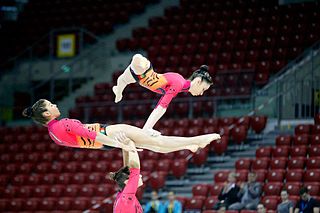
Acrobatic gymnastics is a competitive discipline of gymnastics where partnerships of gymnasts work together and perform figures consisting of acrobatic moves, dance and tumbling, set to music. There are three types of routines; a 'balance' routine where the focus is on strength, poise and flexibility; a 'dynamic' routine which includes throws, somersaults and catches, and a 'combined' routine which includes elements from both balance and dynamic.

Zélia Duncan, born Zélia Cristina Gonçalves Moreira, is a Brazilian singer-songwriter.
Antônio Petrus Kalil, known as Turcão, was one of the operators of the jogo do bicho, a popular illegal lottery in Brazil. Kalil ran the game in a number of towns, including Niteroi, and was one of 14 bicheiros or banqueiros—"bankers" as the game's operators are known—who were sentenced to six years' imprisonment in May 1993 for operating a criminal association. Kalil's brother Jose, known as "Zinho", was among those convicted. Denise Frossard, the judge in the case, wrote in 2007 that it was the first time the existence of a mafia-type organization had been recognized in Brazil. According to Frossard, Kalil was one of the organization's bosses in 1981. In April 2007, he was among 24 people charged for involvement with the illegal lottery, as well as bingo parlours and the distribution of slot machines. On March 13, 2012, he was sentenced to 48 years in prison and a fine of BRL 11 million for conspiracy and corruption, together with the other bicho bosses Anísio Abraão David and Capitão Guimarães.

Human tower is a performance variation of gymnastic formation. Together with the human pyramid, it is exhibited frequently at the climax of the performance. In gymnastics, human tower is the highest and largest mounting. On the shoulder of the components of the base layer, put the feet of components of the second floor. In the same way, the components of higher floors are accumulated. The mounting is performed in sitting postulate. After the conclusion of the mounting, the tower stands up from lower floor to upper ones.

Luigi Cani is a Brazilian stunt performer and cinematographic producer. He is a well known athlete in parachuting.

Gymnastics at the 2016 Summer Olympics in Rio de Janeiro was held in three categories: artistic gymnastics, rhythmic gymnastics and trampolining. All gymnastics events were staged at the Arena Olímpica do Rio from 6 to 21 August 2016.

The closing ceremony of the 2016 Summer Olympics was held on 21 August 2016 from 20:00 to 22:50 BRT at the Maracanã Stadium, Rio de Janeiro, Brazil.
Mao Yi is a former Chinese artistic gymnast. She won the silver medal with the team in 2015 World Gymnastic Championships. She competed in the 2016 Olympic Games, where she and her teammates won a bronze medal in the team event.
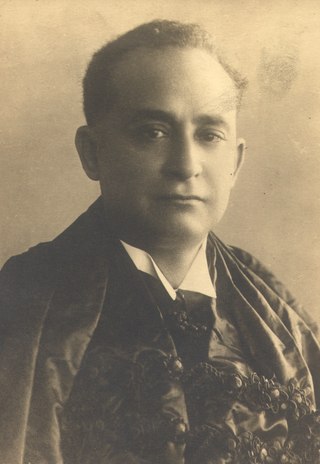
Francisco José de Oliveira Viana (June 20, 1883 – March 28, 1951) was a Brazilian professor, jurist, historian, sociologist, and an imortal of the Brazilian Academy of Letters.
Kazuma Kaya is a Japanese artistic gymnast. He competed at the 2020 Summer Olympics, winning silver with the Japanese team and bronze in the pommel horse. He is a two-time World champion with the Japanese team and a two-time World medalist on the pommel horse. He is the 2019 Universiade team and all-around champion.
Matheus Nascimento de Paula is a Brazilian footballer who currently plays as a forward for Botafogo.
